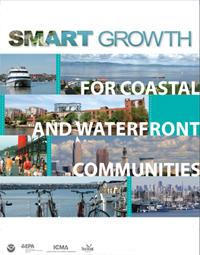EPA and NOAA Partner to Help Coastal Communities
Populations and built environments in coastal watersheds are growing rapidly. In 2011, 53 percent of the U.S. population lived in coastal counties, a number expected to grow by 8 percent by 2020.1 The environmental impacts of development directly affect coastal communities’ ability to balance natural resource protection with sustainable economic growth. These impacts also affect the federal government's ability to achieve national goals for sustainable management of coastal resources and protection of human health and the environment.
The effects of climate change will further challenge coastal communities with sea-level rise, coastal erosion, changes to ecosystems, more intense storm events, and changes in precipitation frequency and volume. Coastal communities need strategies to adapt to these changes to protect residents, businesses, ecosystems, and property.
To help communities respond to these challenges and become more environmentally, economically, and socially sustainable, EPA and the National Oceanic and Atmospheric Administration (NOAA) have renewed their joint agreement to protect the safety, health, and property of people living in or visiting coastal communities.
Under the agreement, the agencies will partner with local communities and other governmental entities to give waterfront communities the tools and resources they need to grow in ways that benefit the economy, public health, and the environment while protecting coastal ecosystems and preparing for the impacts of climate change. EPA and NOAA will:
- Provide technical assistance and training to communities to help them implement more sustainable construction and land use practices.
- Develop innovative, web-based tools to provide essential scientific and technical information to interested communities and other stakeholders.
- Collaborate on the development of the National Coastal Condition Reports that depict the condition of the nation's coastal waters using data collected and analyzed by state agencies.
- Support place-based projects focused on equitable development and climate adaptation in coastal communities.
For example, in August 2011, EPA and NOAA, along with the state Sea Grant College Programs of Hawaii, Rhode Island, and Texas hosted a two-day roundtable meeting of national experts from the fields of smart growth, hazard mitigation, climate change adaptation, and coastal management. The report from the roundtable, Achieving Hazard-Resilient Coastal and Waterfront Smart Growth, summarizes the discussion about how coastal and waterfront communities could improve quality of life, use land and other resources efficiently, and create environmentally and economically sustainable neighborhoods while minimizing risks from natural hazards related to coastal and waterfront flooding.
This agreement builds on the 2005-2010 EPA-NOAA partnership that provided resilience and smart growth training to over 400 coastal community officials and developed the publication Smart Growth for Coastal and Waterfront Communities. The agencies also collaborated on Smart Growth Implementation Assistance for Coastal Communities to help coastal communities examine options for implementing smart growth approaches.
Read the Memorandum of Agreement between EPA and NOAA.
Learn more about smart growth and climate change.
For more information on the EPA-NOAA partnership, please contact:
- Kathleen Bailey (bailey.kathleen@epa.gov, 202-566-2953), EPA's Office of Sustainable Communities.
- Jamal Kadri (kadri.jamal@epa.gov, 202-566-1248), EPA's Office of Water.
1 From NOAA's State of the Coast website (no longer active). Data source: Woods and Poole Economics, Inc. 2010. Complete Economic and Demographic Dataset. Exit Data processed by NOAA to determine coastal county summary totals and absolute and percent change.

